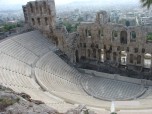Erected in 334 BC, the Choragic Monument of Lysicrates can be thought of as the Oscar, or the Academy Award of ancient times. On top of the structure rests the much coveted first place prize for the best Greek play of the year. The monument was bankrolled by an extremely wealthy citizen by the name of Lysicrates. He not only provided the first place award, but also built a choragic monument upon which the trophy was to be displayed.
Little today is known about Lysicrates except that he was the “choregos” of the day. This was the title of the citizen who bankrolled the all aspects of ancient Greek theater, although such arts also received some public financing.
The choregos was the primary money man. He paid for things like costumes, actor’s fees, set design, , the bands and instruments. Essentially, Lysicrates paid for the same aspects that involve putting on a modern Broadway or any live theater production today. As the patron of the winning play, Lysicrates co-shared the top prize, much like when the producer of a modern day movie receives an Oscar for best film of the year.
The Choragic Monument of Lysicrates is highly significant because it is one of very few of its kind to have survived the times intact. Many such monuments once lined the avenues in this section of Athens, but most have since crumbled or been lost.
The Choragic Monument of Lysicrates stands near the Acropolis in Athens. It is 30 feet tall. The bottom of the monument is a large square base upon which is mounted a circular, columnar structure called the “tholos.” The columns are of Corinthian style. It is topped with a marble roof on which stands a “capital” of designed acanthus leaves. On top of this would have been placed a bronze trophy which was the First Price award.
There is also a frieze below the roof showing scenes from the very play honored by the monument. In this case we see the god Dionysus doing battle with Tyrrhenian pirates. Dionysus is victorious, transforming the pirates into dolphins.
Although the Choragic Monument of Lysicrates celebrates the pagan gods and performances took place in the Theater of Dionysus, history has a group of Christian monks to thank for the preservation of the object. The monument was purchased and integrated into a Campuchin Monastery in 1669.
The Choragic Monument of Lysicrates has had lasting influence. Its image and design became popular throughout Europe during and after the Renaissance. It inspired the design of many imitators, and has also been used as a model for whole buildings. By the 19th century, the monument was considered a primary symbol of the brilliance of ancient Greek art and culture.
Visitors to Athens today can observe the Choragic Monument of Lysicrates where it stands in a garden area on Tripodon Street.





















